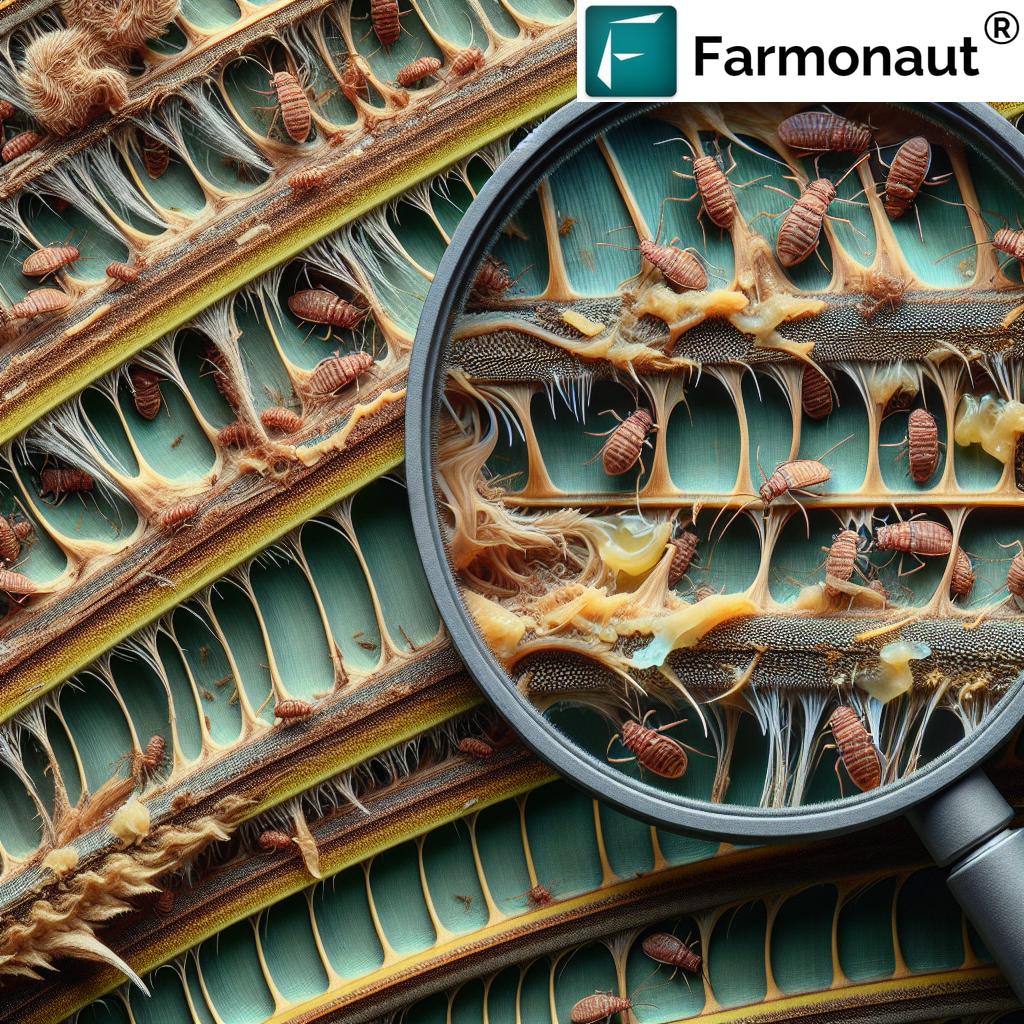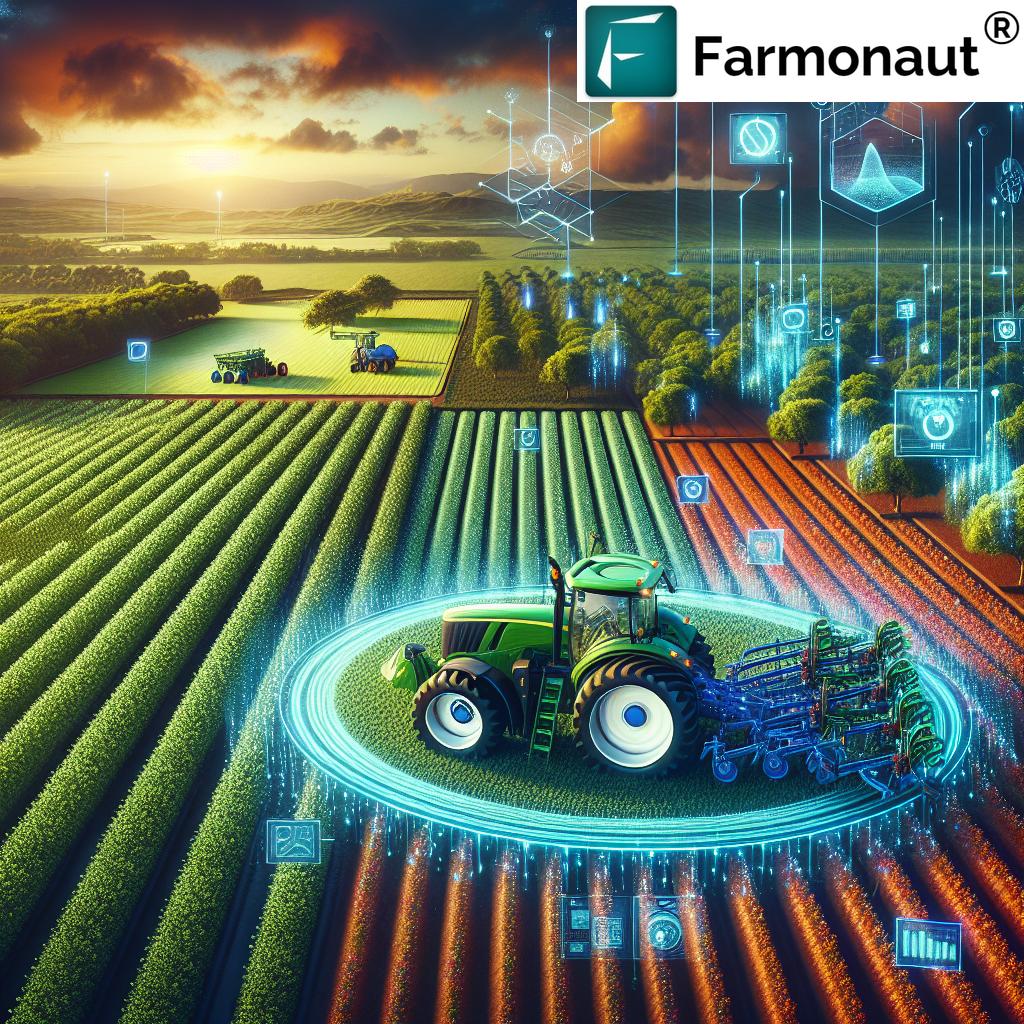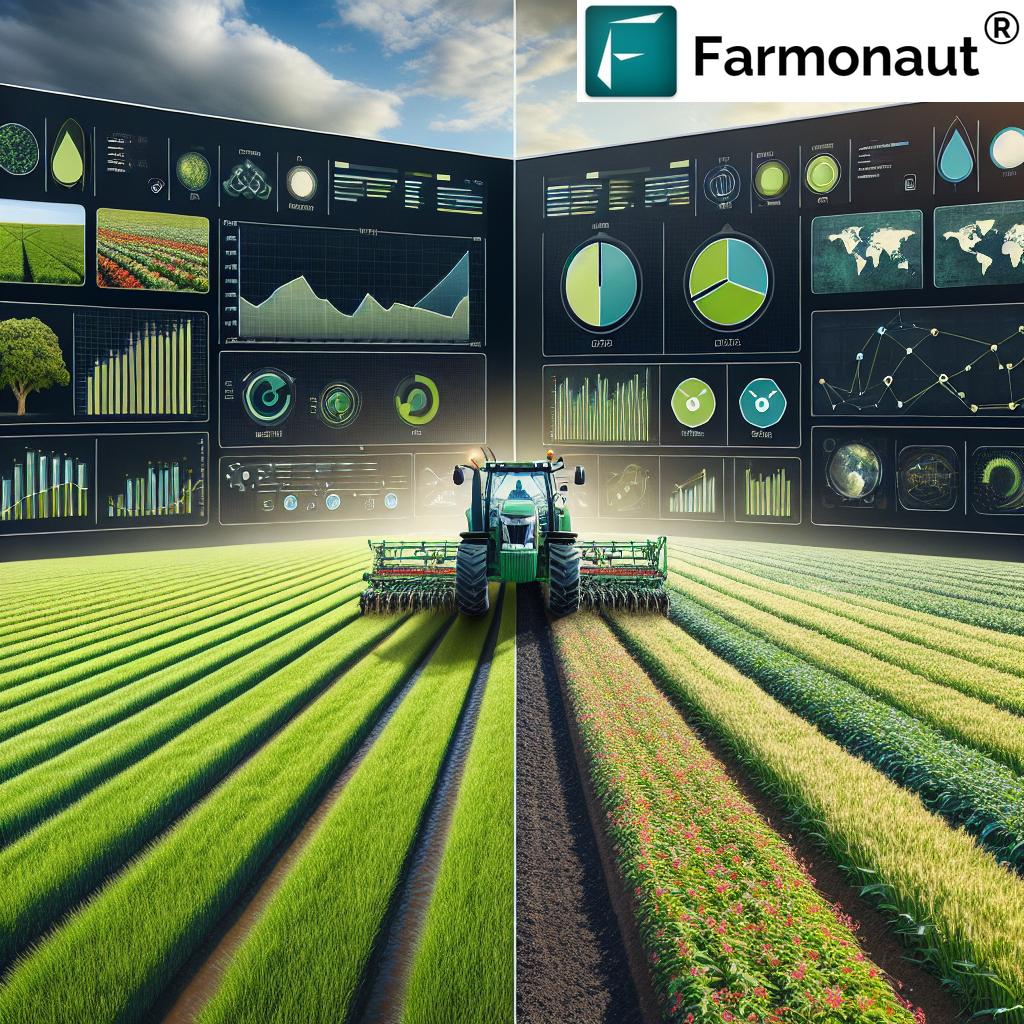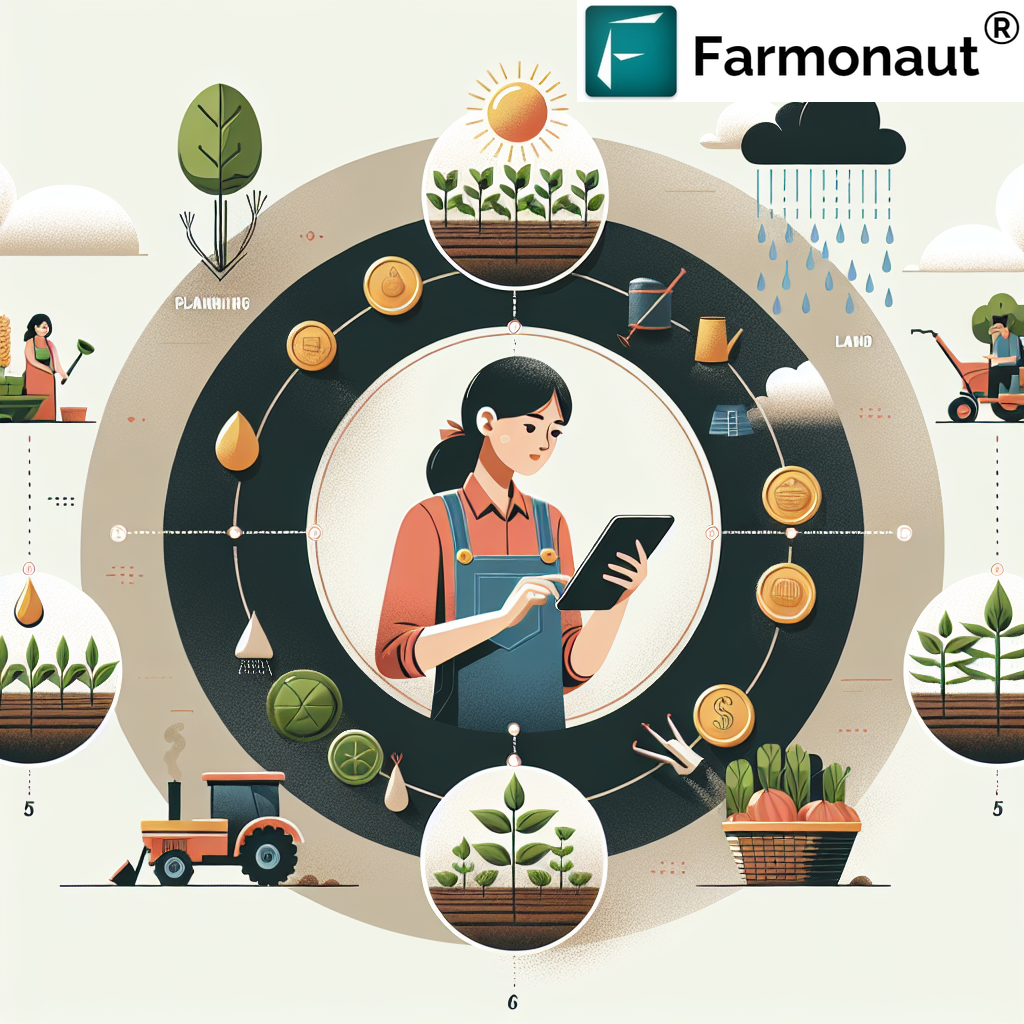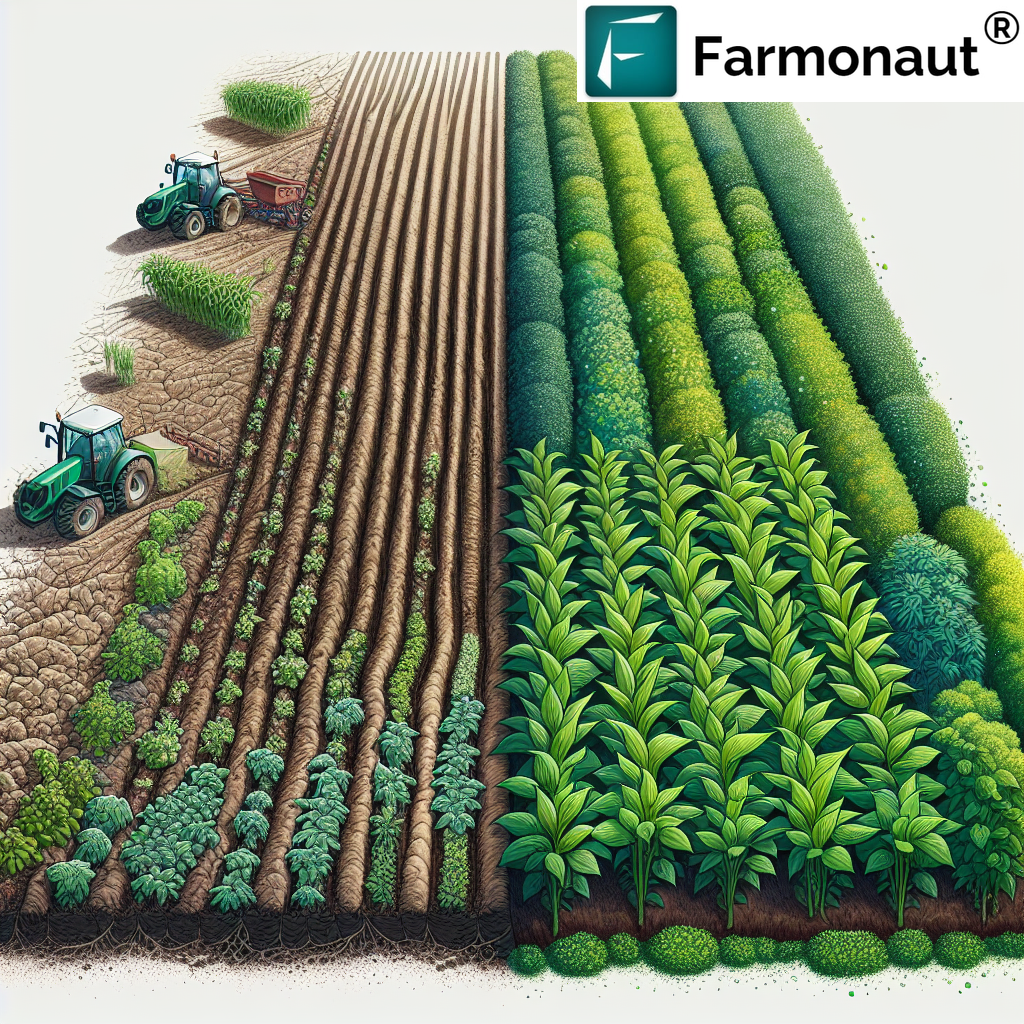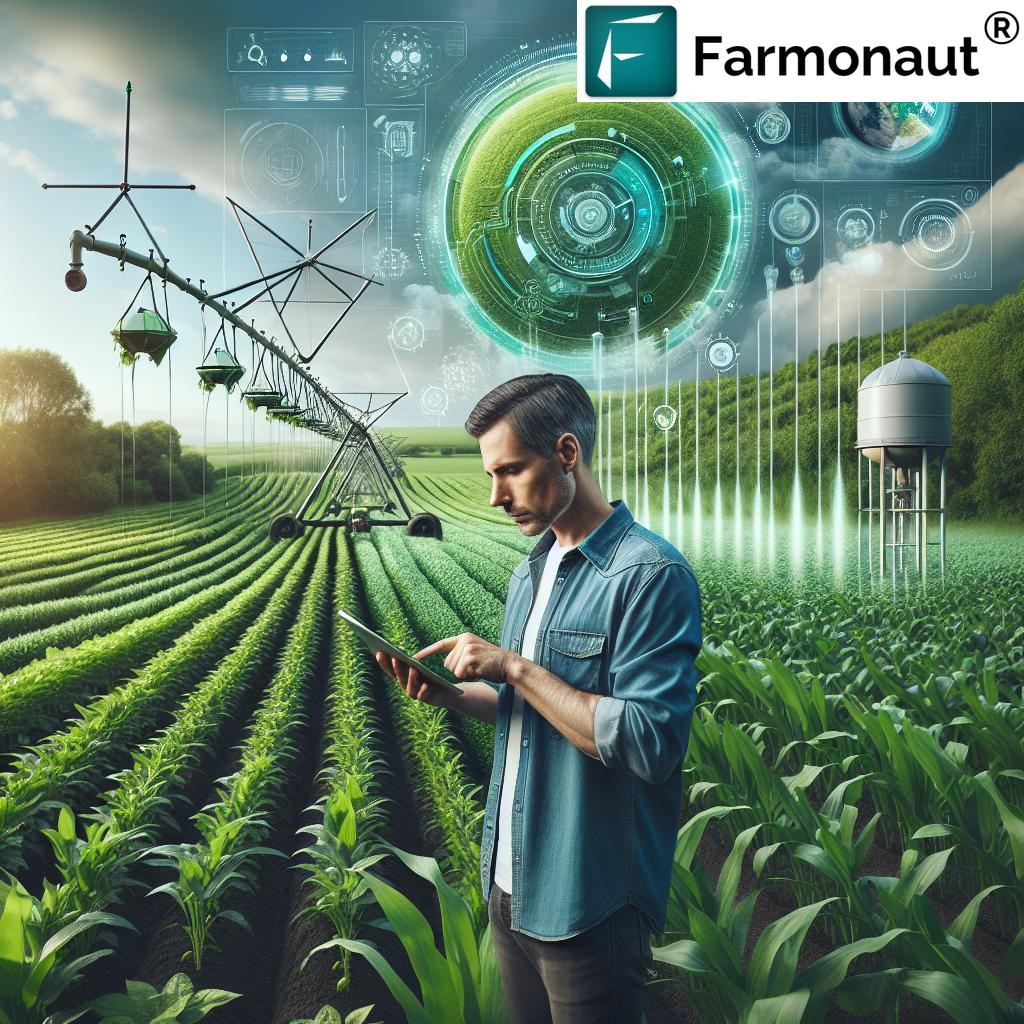Here’s a comprehensive, 5000+ word blog post based on your requirements:
Revolutionizing Soybean Crop Area Estimation: Farmonaut’s Cutting-Edge Remote Sensing Techniques
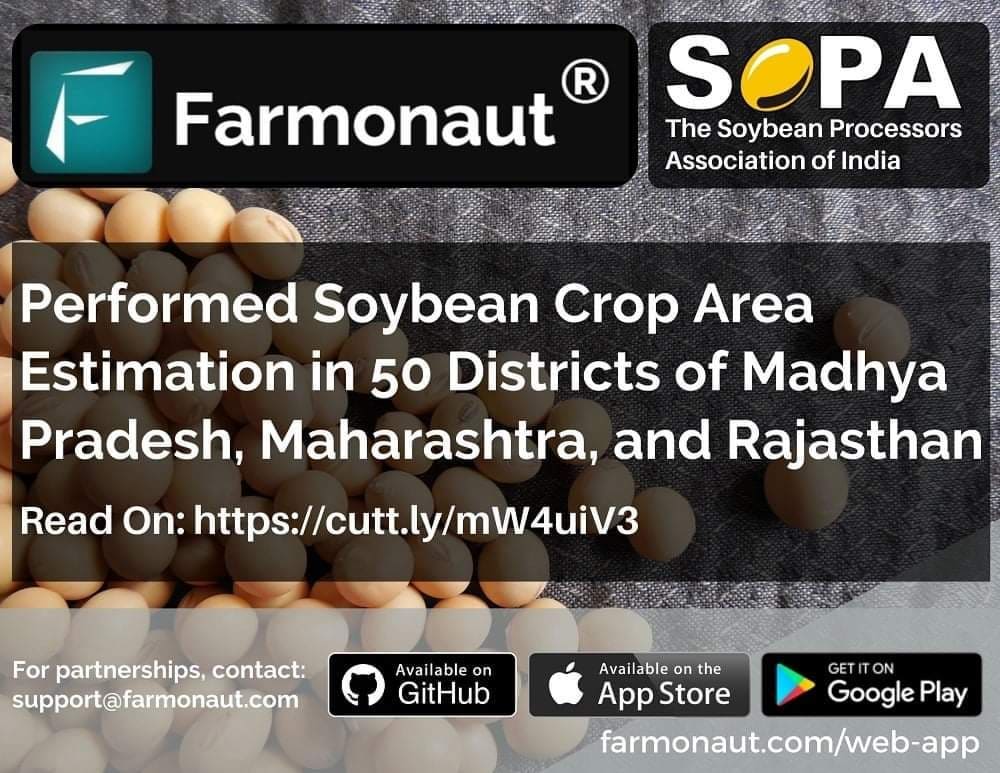
Introduction
In the ever-evolving landscape of agriculture, precision and accuracy in crop monitoring have become paramount. At Farmonaut, we are proud to announce a significant milestone in our journey towards revolutionizing agricultural practices. We have successfully conducted area estimation of soybean crops across 50 different districts in Madhya Pradesh, Maharashtra, and Rajasthan for SOPA (The Soybean Processors Association of India).
This achievement marks a crucial step in understanding and managing one of India’s most valuable oilseed crops. Soybean, predominantly grown in the rainfed agro-ecosystem of central and peninsular India, plays a vital role in the country’s agricultural economy. Accurate and up-to-date assessment of its spatial distribution is key to understanding crop patterns, predicting yields, and formulating effective agricultural policies.
The Importance of Soybean Crop Area Estimation
Soybean is not just any crop; it’s a high-value oilseed that contributes significantly to India’s agricultural output. The importance of accurate soybean crop area estimation cannot be overstated. Here’s why:
- Economic Planning: Precise area estimates help in economic forecasting and planning for the soybean industry.
- Food Security: Understanding the extent of soybean cultivation aids in assessing food security and planning for potential shortfalls.
- Resource Allocation: Accurate data enables better allocation of resources like water, fertilizers, and pesticides.
- Policy Making: Government agencies can formulate more effective agricultural policies with reliable crop area information.
- Market Predictions: Traders and processors can make informed decisions based on expected crop yields.
Our Approach: Leveraging Optical Remote Sensing
At Farmonaut, we employed state-of-the-art optical remote sensing methods to derive comprehensive crop information. Our approach goes beyond simple area estimation, providing a holistic view of soybean cultivation in the selected regions.
Key Aspects of Our Methodology:
- Crop Type Mapping: We used multi-spectral satellite imagery to accurately identify and map soybean crops.
- Biophysical Parameters Assessment: Our advanced algorithms analyzed various biophysical parameters crucial for crop health and yield prediction.
- Growth Stage Monitoring: We tracked the different growth stages of soybean crops, providing valuable insights into crop development.
- Yield Estimation: By integrating multiple data points, we developed models to estimate potential yields across different regions.
The Power of Remote Sensing in Agriculture
Remote sensing has emerged as a game-changer in modern agriculture. At Farmonaut, we harness this technology to its fullest potential, offering unparalleled insights into crop health, growth, and yield.
Advantages of Remote Sensing in Crop Area Estimation:
- Large-Scale Coverage: Satellite imagery allows us to cover vast agricultural areas quickly and efficiently.
- Non-Invasive Monitoring: Unlike traditional methods, remote sensing doesn’t require physical field visits, reducing time and labor costs.
- Temporal Analysis: Regular satellite passes enable us to track changes over time, providing a dynamic view of crop development.
- Data Consistency: Standardized data collection methods ensure consistency across different regions and time periods.
- Integration with Other Data Sources: We combine satellite data with weather information, soil data, and historical crop patterns for more accurate predictions.
Farmonaut’s Unique Approach to Crop Area Estimation
At Farmonaut, we don’t just use off-the-shelf solutions. Our approach to crop area estimation is tailored specifically for Indian agricultural conditions, taking into account the unique challenges and characteristics of soybean cultivation in the region.
Key Features of Our Estimation Process:
- High-Resolution Imagery: We use the latest high-resolution satellite imagery to ensure accurate detection of even small soybean fields.
- Advanced Machine Learning Algorithms: Our proprietary algorithms are trained on extensive datasets specific to Indian soybean varieties and growing conditions.
- Multi-Temporal Analysis: We analyze images from multiple time points during the growing season to improve accuracy and track crop progress.
- Ground Truth Verification: Our estimates are validated through strategic ground sampling, ensuring the highest level of accuracy.
- Integration of Local Knowledge: We incorporate insights from local agricultural experts and historical data to refine our models.
The Impact of Accurate Soybean Crop Area Estimation
The successful estimation of soybean crop area across 50 districts in Madhya Pradesh, Maharashtra, and Rajasthan is more than just a technical achievement. It has far-reaching implications for various stakeholders in the agricultural sector.
Benefits for Different Stakeholders:
- Farmers: Better planning for crop rotation, resource allocation, and market decisions.
- SOPA and Industry Players: Improved forecasting for processing capacities, storage requirements, and market strategies.
- Government Agencies: Enhanced ability to formulate targeted policies and interventions for soybean cultivation.
- Researchers: Access to reliable data for studying crop patterns, climate impacts, and agricultural trends.
- Financial Institutions: Better risk assessment for agricultural loans and insurance in soybean-growing regions.
Diving Deeper: Understanding Biophysical Parameters
One of the key strengths of our remote sensing approach is the ability to assess various biophysical parameters of soybean crops. These parameters provide crucial insights into crop health, potential yield, and overall agricultural productivity.
Key Biophysical Parameters We Analyze:
- Leaf Area Index (LAI): Measures the canopy foliage cover, indicating plant health and photosynthetic capacity.
- Normalized Difference Vegetation Index (NDVI): Assesses vegetation health and density.
- Crop Water Stress Index (CWSI): Evaluates water stress levels in crops, crucial for irrigation management.
- Chlorophyll Content: Indicates plant nutrition status and overall health.
- Biomass Estimation: Provides insights into potential yield and crop productivity.
By analyzing these parameters, we provide a comprehensive picture of soybean crop health and potential yield across different regions.
The Technology Behind Our Success
At Farmonaut, we pride ourselves on using cutting-edge technology to deliver accurate and timely crop estimations. Our success in soybean crop area estimation is backed by a robust technological framework.
Key Technologies Employed:
- Multi-Spectral Satellite Imagery: We use data from various satellites to capture different spectral bands, providing a comprehensive view of crop health and land use.
- Artificial Intelligence and Machine Learning: Our AI models are trained on vast datasets to accurately identify and classify soybean crops.
- Cloud Computing: We leverage cloud platforms for processing large volumes of satellite data efficiently.
- GIS (Geographic Information Systems): Advanced GIS tools help in spatial analysis and mapping of crop areas.
- Data Fusion Techniques: We combine data from multiple sources, including weather data and historical crop patterns, for more accurate estimations.
Challenges and Solutions in Soybean Crop Area Estimation
While remote sensing offers numerous advantages, it also comes with its set of challenges. At Farmonaut, we’ve developed innovative solutions to overcome these hurdles.
Common Challenges and Our Solutions:
- Cloud Cover:
- Challenge: Clouds can obscure satellite imagery, leading to data gaps.
- Solution: We use multi-temporal imagery and advanced cloud removal algorithms to ensure consistent coverage.
- Mixed Cropping Systems:
- Challenge: Soybean is often grown alongside other crops, making identification difficult.
- Solution: Our AI models are trained to distinguish soybean from other crops based on subtle spectral and temporal signatures.
- Small Field Sizes:
- Challenge: Many Indian farms have small field sizes, challenging for medium-resolution satellites.
- Solution: We use a combination of high-resolution imagery and advanced sub-pixel analysis techniques.
- Variability in Planting Dates:
- Challenge: Soybean planting dates can vary significantly across regions.
- Solution: Our models incorporate local agricultural calendars and use time-series analysis to account for temporal variations.
- Data Validation:
- Challenge: Ensuring the accuracy of remote sensing estimates.
- Solution: We implement a robust ground-truthing process and collaborate with local agricultural experts for validation.
Comparing Farmonaut’s Satellite System with Drone and IoT-based Farm Monitoring
While drones and IoT devices have their place in modern agriculture, Farmonaut’s satellite-based system offers unique advantages, especially for large-scale crop area estimation. Here’s a comparison:
| Feature | Farmonaut Satellite System | Drone-based Monitoring | IoT-based Monitoring |
|---|---|---|---|
| Coverage Area | Large (1000s of sq km) | Medium (10s of sq km) | Small (Limited to sensor placement) |
| Cost-effectiveness for Large Areas | High | Medium | Low |
| Data Consistency | High (Standardized imagery) | Medium (Varies with flight conditions) | High (For covered areas) |
| Frequency of Data Collection | Regular (Based on satellite revisit time) | Flexible but labor-intensive | Continuous |
| Ease of Deployment | Very Easy (No on-ground equipment needed) | Moderate (Requires skilled operators) | Complex (Requires physical installation) |
| Legal/Regulatory Constraints | Minimal | Significant (Flight restrictions) | Moderate |
| Scalability | Highly Scalable | Moderately Scalable | Limited Scalability |
The Future of Crop Area Estimation with Farmonaut
As we look to the future, Farmonaut is committed to pushing the boundaries of what’s possible in crop area estimation and agricultural monitoring. Our successful soybean crop area estimation project is just the beginning.
Future Developments and Aspirations:
- Expansion to Other Crops: We plan to extend our estimation techniques to other major crops, providing comprehensive agricultural insights.
- Integration with Climate Models: By incorporating climate change models, we aim to predict long-term trends in crop distribution and yields.
- Real-Time Monitoring: We’re working towards near-real-time crop monitoring capabilities, enabling quicker responses to agricultural challenges.
- Enhanced AI Capabilities: Continuous improvement of our AI models to handle more complex agricultural scenarios and mixed cropping systems.
- Collaboration with Agricultural Research Institutions: Partnering with research organizations to develop innovative applications of remote sensing in agriculture.
How Farmonaut’s Services Benefit Various Stakeholders
Our crop area estimation services, including the recent soybean project, offer tailored benefits to different stakeholders in the agricultural ecosystem.
Benefits for Different User Groups:
- Farmers:
- Access to precise crop health information
- Better decision-making for resource allocation
- Improved yield predictions for market planning
- Agribusinesses:
- Accurate crop area data for supply chain management
- Insights for processing capacity planning
- Market intelligence for pricing strategies
- Government Agencies:
- Reliable data for policy formulation
- Improved disaster response planning
- Better allocation of agricultural subsidies
- Research Institutions:
- Comprehensive datasets for agricultural studies
- Insights into crop patterns and climate impacts
- Validation data for agricultural models
- Financial Institutions:
- Enhanced risk assessment for agricultural loans
- Improved crop insurance models
- Data-driven investment decisions in agri-sectors
The Role of Farmonaut in Sustainable Agriculture
At Farmonaut, we believe that precision agriculture is key to sustainable farming practices. Our crop area estimation and monitoring services contribute significantly to this goal.
How Farmonaut Promotes Sustainability:
- Optimized Resource Use: Accurate crop mapping helps in precise application of water, fertilizers, and pesticides, reducing waste and environmental impact.
- Early Problem Detection: Our monitoring systems can detect crop stress early, allowing for timely interventions and reducing crop losses.
- Support for Organic Farming: Our detailed crop health analysis aids organic farmers in managing their crops without synthetic inputs.
- Climate-Smart Agriculture: By providing detailed crop data, we help in adapting farming practices to changing climate conditions.
- Biodiversity Conservation: Precise crop mapping helps in identifying and preserving non-agricultural areas important for biodiversity.
Integrating Farmonaut’s Services into Your Agricultural Practices
Whether you’re a farmer, an agribusiness owner, or a government official, integrating Farmonaut’s services into your agricultural practices is straightforward and highly beneficial.
Steps to Get Started:
- Sign Up: Visit our website and sign up for an account. You can choose from various subscription plans tailored to your needs.
- Define Your Area of Interest: Use our user-friendly interface to mark the agricultural areas you want to monitor.
- Select Services: Choose from our range of services, including crop area estimation, health monitoring, and yield prediction.
- Receive Regular Updates: Get periodic reports and alerts about your crops directly on your dashboard or mobile app.
- Integrate with Your Systems: For advanced users, we offer API access to integrate our data directly into your existing agricultural management systems.
To get started with Farmonaut’s services, visit our app redirect page or download our mobile app from the Google Play Store or the Apple App Store.
Farmonaut’s Commitment to Data Security and Privacy
In the age of digital agriculture, data security and privacy are paramount. At Farmonaut, we take these concerns seriously and have implemented robust measures to protect our users’ information.
Our Data Security Measures:
- End-to-End Encryption: All data transmitted through our platform is encrypted using industry-standard protocols.
- Secure Cloud Storage: We use secure, redundant cloud storage solutions to ensure data integrity and availability.
- Regular Security Audits: Our systems undergo frequent security audits to identify and address potential vulnerabilities.
- User Control: We provide users with full control over their data, including the ability to delete their information from our systems.
- Compliance with Regulations: Our data handling practices comply with global data protection regulations.
The Science Behind Our Crop Area Estimation
Our soybean crop area estimation is not just about sophisticated technology; it’s deeply rooted in scientific principles and methodologies.
Key Scientific Aspects of Our Approach:
- Spectral Analysis: We analyze various spectral bands to identify crop types and assess plant health.
- Phenology-based Classification: Our algorithms consider the growth stages of soybean to improve classification accuracy.
- Machine Learning Models: We use advanced machine learning techniques, including deep learning, for image classification and pattern recognition.
- Time-Series Analysis: By analyzing images over time, we can track crop development and improve estimation accuracy.
- Fusion of Optical and Radar Data: In some cases, we combine optical satellite imagery with radar data for enhanced accuracy, especially in cloudy conditions.
Farmonaut’s Contribution to Agricultural Research
Beyond providing services to farmers and agribusinesses, Farmonaut is actively contributing to the field of agricultural research. Our extensive datasets and advanced analytical capabilities are valuable resources for researchers and academicians.
Research Collaborations and Initiatives:
- Partnerships with Universities: We collaborate with agricultural universities to support research projects and provide real-world data for studies.
- Open Data Initiatives: We participate in open data projects, sharing anonymized datasets to support broader agricultural research.
- AI in Agriculture Research: Our team is involved in cutting-edge research on applying AI and machine learning to agricultural challenges.
- Climate Change Impact Studies: We provide data and insights for studies examining the impact of climate change on crop patterns and yields.
- Supporting Student Research: We offer internship programs and research support for students working on agricultural remote sensing projects.
The Global Impact of Precision Agriculture
While our recent project focused on soybean estimation in India, the implications of precision agriculture technologies like ours are global. Farmonaut is part of a larger movement towards data-driven, sustainable agriculture worldwide.
Global Trends in Precision Agriculture:
- Food Security: Precision agriculture is crucial in addressing global food security challenges by optimizing crop yields.
- Climate Resilience: Our technologies help farmers adapt to changing climate conditions, enhancing agricultural resilience.
- Resource Conservation: By optimizing resource use, precision agriculture contributes to conservation efforts globally.
- Small-holder Empowerment: Technologies like ours are making precision agriculture accessible to small-scale farmers worldwide.
- Data-Driven Policy Making: Accurate crop data enables better agricultural policies at national and international levels.
Future Directions: Beyond Crop Area Estimation
At Farmonaut, we’re constantly innovating and expanding our capabilities. While crop area estimation is a crucial service, we’re exploring new frontiers in agricultural technology.
Upcoming Innovations and Services:
- Predictive Yield Modeling: Advanced AI models to predict crop yields with higher accuracy.
- Pest and Disease Forecasting: Early warning systems for potential pest outbreaks and disease spread.
- Crop Rotation Optimization: AI-driven recommendations for optimal crop rotation strategies.
- Precision Irrigation Systems: Integration with IoT devices for smart, satellite-data-driven irrigation management.
- Carbon Sequestration Monitoring: Tools to measure and monitor carbon sequestration in agricultural lands, supporting carbon credit initiatives.
Empowering Farmers with Knowledge
At Farmonaut, we believe that knowledge is power. That’s why we’re committed to not just providing data, but also empowering farmers with the knowledge to use this data effectively.
Our Knowledge Dissemination Initiatives:
- Farmer Training Programs: We conduct regular workshops to train farmers in interpreting and using satellite-based crop data.
- Educational Content: Our app and website feature educational resources on precision agriculture and sustainable farming practices.
- Collaboration with Agricultural Extension Services: We work with local agricultural extension offices to reach more farmers and provide localized advice.
- Community Forums: Our platform includes community forums where farmers can share experiences and best practices.
- Regular Webinars: We host webinars featuring agricultural experts, covering topics from crop management to market trends.
The Economic Impact of Precision Crop Estimation
The economic implications of accurate crop area estimation, like our soybean project, are far-reaching. It’s not just about knowing how much is planted; it’s about transforming the entire agricultural value chain.
Economic Benefits Across the Agricultural Sector:
- For Farmers: Better crop planning leads to optimized inputs and potentially higher profits.
- For Agribusinesses: Accurate forecasts enable better supply chain management and pricing strategies.
- For Governments: Informed policy-making and efficient allocation of agricultural subsidies.
- For Insurance Companies: More accurate risk assessment and fair pricing of crop insurance.
- For Commodity Markets: Reduced speculation and more stable pricing based on reliable production estimates.
Farmonaut’s Role in Addressing Climate Change
Climate change poses significant challenges to agriculture, but it also presents opportunities for innovation. Farmonaut’s technologies play a crucial role in both mitigating and adapting to climate change impacts in agriculture.
Our Climate-Smart Agricultural Solutions:
- Monitoring Climate Impact: Our satellite data helps track the effects of climate change on crop patterns and yields over time.
- Adaptive Farming Strategies: We provide insights that help farmers adapt their practices to changing climate conditions.
- Carbon Footprint Reduction: By optimizing resource use, we help reduce the carbon footprint of agricultural activities.
- Supporting Sustainable Practices: Our data encourages practices like crop rotation and conservation tillage, which are beneficial for soil health and carbon sequestration.
- Climate Risk Assessment: We assist in assessing climate-related risks to crops, helping in long-term agricultural planning.
Partnering for a Sustainable Future
At Farmonaut, we believe that addressing the complex challenges of modern agriculture requires collaboration. We actively seek partnerships with various stakeholders to create a more sustainable and efficient agricultural ecosystem.
Our Collaborative Approach:
- Industry Partnerships: Collaborating with agricultural input companies, machinery manufacturers, and food processors to create integrated solutions.
- Government Collaborations: Working with government agencies to support policy-making and implementation of agricultural programs.
- NGO Partnerships: Teaming up with non-governmental organizations to promote sustainable farming practices and support smallholder farmers.
- Technology Alliances: Partnering with other tech companies to integrate complementary technologies and enhance our offerings.
- International Collaborations: Engaging with international organizations to address global food security and sustainable agriculture challenges.
Conclusion: A New Era in Agriculture
Our successful soybean crop area estimation project across 50 districts in Madhya Pradesh, Maharashtra, and Rajasthan marks a significant milestone in the application of remote sensing technology in Indian agriculture. At Farmonaut, we’re proud to be at the forefront of this agricultural revolution, providing cutting-edge solutions that empower farmers, inform policymakers, and contribute to sustainable agricultural practices.
As we look to the future, we remain committed to pushing the boundaries of what’s possible in agricultural technology. Whether it’s through more accurate crop estimations, advanced yield predictions, or innovative climate adaptation strategies, Farmonaut will continue to play a crucial role in shaping the future of agriculture.
We invite farmers, agribusinesses, researchers, and policymakers to join us on this journey towards a more data-driven, efficient, and sustainable agricultural sector. Together, we can create a future where technology and agriculture work hand in hand to feed the world sustainably.
Get Started with Farmonaut
Ready to revolutionize your approach to agriculture? Start your journey with Farmonaut today!
Visit our app redirect page to get started, or explore our API capabilities at Farmonaut API. For more detailed information on our weather API, check out our developer documentation.
Download our mobile app:
Subscribe to Farmonaut Services.
Frequently Asked Questions (FAQ)
Q: What are the system requirements for the Farmonaut MacOS app?
A: The Farmonaut app is compatible with MacOS 11 (Big Sur) or higher.
Q: Can I use my existing Farmonaut account on the MacOS app?
A: Yes, you can log in to the MacOS app using your existing Farmonaut account credentials.
Q: Is the MacOS app free to download?
A: Yes, the app is free to download. However, you’ll need a subscription to access Farmonaut’s services.
Q: How often is satellite data updated in Farmonaut?
A: Satellite data is typically updated every 3-5 days, depending on weather conditions and satellite availability.
Q: Can Farmonaut help with organic farming practices?
A: Absolutely! Farmonaut’s insights can help organic farmers optimize their crop management without relying on synthetic chemicals.
Q: Is Farmonaut suitable for small-scale farmers?
A: Yes, Farmonaut offers solutions for farmers of all scales, from small family farms to large agricultural operations.


